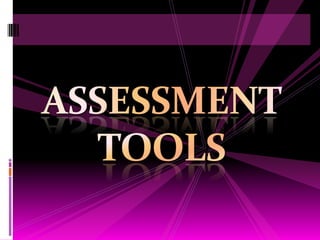Ppt 101 ferdinand and mujar
- 2. ’ü▒Allow teachers to measure how well students have understood a topic.
- 3. CONCEPT TESTS/MAPS ’üČ CONCEPT TEST. Conceptual multiple- choice questions that are useful in large classes. ’üČ CONCEPT MAP. A diagramming technique for assessing how well students see the ŌĆ£big pictureŌĆØ.
- 4. KNOWLEDGE SURVEY ’āśStudents answer whether they could answer a survey of course content questions.
- 5. ORAL PRESENTATIONS ’üČ ORAL FLUENCY. An informal assessment of reading to determine oral reading errors or assessment miscues. ’üČ ORAL READING. An oral & silent reading assessment used for diagnosing studentŌĆÖs assessment developmental literacy levels through oral retelling & an individual reading inventory.
- 6. ASSIGNMENTS ’āśRefers to tasks assigned to students by their teachers to completed outside of class.
- 7. POSTER PRESENTATIONS ’āśA poster session/poster presentation is the presentation of research information by an individual or representatives of research teams at a congress or conference with an academic or professional focus. The work is usually peer reviewed.
- 8. PEER REVIEW/FOCUSED GROUP ’āśHaving students assess themselves & each other.
- 9. PORTFOLIOS ’āśA collection of evidence to demonstrate mastery of a given set of concepts.
- 10. OBSERVATIONS ’āśAn informal assessment technique of watching students to identify strengths & weaknesses, patterns of behavior & cognitive strategies. Observations help determine which studentŌĆÖs need additional support & how to adjust instruction to encourage more & better learning.
- 11. Rubrics ’āśA set of evaluation criteria based on learning goals & student performance.
- 12. PERFORMANCE BASED-TASKS ’āś Maybe administered as either dependent/independent activities. A s dependent activities/performance tasks are accompanied by selected response & or constructed response items that set the stage & provide context for the creation of a resulting product or performance.
- 13. LABORATORY METHOD ’āśEducating students in a laboratory performing a hands-on-experiments.
- 14. 8 STEP PROCESS SCHOOLS CAN USE TO ASSESS STUDENT LEARNING: 1. DECIDE what skill cluster to assess & select a broad assessment that captures more than one attribute of the domain. 2. CONSTRUCT or use existing scoring guides or rubrics for the task.
- 15. 3. SHARE the task & scoring criteria with staff. 4. ADMISTER the task to students in a similar time frame. 5. SPEND TIME discussing the scoring criteria and agreeing on anchor paper.
- 16. 6. RATE the studentŌĆÖs paper. It is often useful to have the papers noted by a teacher who is not the studentŌĆÖs own instructor for the subject. 7. COMPARE ratings, discuss & formulate implications for instructional delivery. 8. DATA can be reported in terms of the percentage of students meeting the criteria at the various points.
- 17. thereŌĆÖs no one ŌĆ£true wayŌĆØ to measure or assess different abilities or learning outcomes.


















